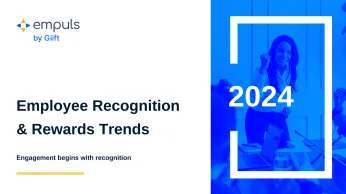Encuestas de empleados: Tipos y cómo utilizarlas eficazmente
Las encuestas a los empleados desempeñan un papel fundamental a la hora de conocer el sentimiento en el lugar de trabajo, mejorar el compromiso y fomentar una cultura laboral positiva. Desde las encuestas del pulso hasta las evaluaciones del compromiso, los distintos tipos de encuestas de empleados proporcionan información valiosa sobre las experiencias de los empleados.
En esta página
- ¿Qué es una encuesta de empleados?
- The benefits of employee surveys: Why should you conduct them?
- Different types of employee surveys
- The Do's and Don'ts of employee surveys
- Employee survey best practices
- Employee survey questions about management
- Leverage Empuls employee survey tool: Unlock actionable insights to boost engagement
- Conclusión
- Preguntas frecuentes
A single employee survey can drive significant business impact. SAP, a global software giant, proved this when a simple survey led to a 1% improvement in its Business Health Culture Index (BHCI), resulting in an operating profit boost of €90-100 million.
By consistently measuring employee sentiment, SAP linked engagement levels to business performance, proving that a well-executed survey goes beyond just collecting feedback—it shapes company culture, improves retention, and drives growth.
When done right, employee surveys provide invaluable insights into workforce satisfaction, productivity, and areas needing improvement. They help organizations make data-backed decisions, ensuring employees feel heard and valued. However, crafting an effective survey requires careful planning—choosing the right types of employee surveys, structuring questions correctly, and acting on the results.
In this blog, we’ll break down everything you need to know about employee surveys—from the different types and best practices to what to avoid—so you can harness the full potential of employee feedback and build a thriving workplace.
¿Qué es una encuesta de empleados?
An employee survey is a tool containing a questionnaire. It is designed to gather feedback from employees about their work experience. Organizations essentially use it to gauge employee sentiment on various aspects of the workplace. With a properly documented employee survey, an organization can record.
- Mayor retención de los empleados
- Mejora de la toma de decisiones
- Aumento de la moral de los empleados
- Mayor compromiso de los empleados
- Identificación de áreas de mejora
- Detección precoz de problemas
The importance of employee surveys reflects the company culture. The impact of employee surveys extends even further. This connection between employee satisfaction and financial success is no coincidence.
Let's delve deeper into the quantifiable benefits of implementing an employee survey program.
- According to Gallup research, organizations with high employee engagement scores see 21% greater profitability.
- To interlink the study of profitability with employees’ psychological stance that impacts the retention rate of an organization, Gallup also found that engaged employees indeed are less likely to miss work and more productive.
- According to a study by MIT's Center for Information Systems Research, companies with a strong focus on employee experience see 4 times the revenue growth and 2 times the innovation compared to competitors.
- Gallup data shows a mere 34% of U.S. employees are engaged. This presents a significant chance to boost workplace satisfaction and employee productivity.
Las cifras son suficientes para demostrar la importancia de implantar un programa de encuestas a los empleados. Si aprovecha la voz colectiva de sus empleados, podrá descubrir una gran cantidad de información que impulsará a su empresa hacia un mayor éxito. Sin embargo, para introducir la encuesta en la estructura organizativa, debe conocer el tipo para calibrar la información adecuada.
The benefits of employee surveys: Why should you conduct them?
Employee surveys play a vital role in achieving this goal by providing a wealth of data-driven insights that can be leveraged to improve various aspects of the employee experience.
Let's explore the key benefits of conducting employee surveys regularly:
1. Improved decision-making
One of the most significant advantages of employee surveys is their ability to inform strategic HR decisions. Surveys provide a direct line to employee sentiment, uncovering areas of satisfaction and dissatisfaction.
This data allows HR professionals and leadership teams to make evidence-based decisions regarding compensation and benefits packages, training and development programs, and performance management practices.
For example, survey results might reveal a strong desire for professional development opportunities. HR can then implement targeted programs to address this need, ultimately enhancing employee skills and satisfaction.
2. Aumento del compromiso
Employee engagement is a critical metric for organizational success. Engaged employees are more motivated, productive, and loyal. Employee surveys foster engagement by demonstrating that management values employee input and is actively seeking ways to improve the workplace.
When employees feel their voices are heard and valued, they are more likely to feel connected to their work and invested in the organization's success. 89% HR leaders agree that ongoing peer feedback and check-ins are key for successful outcomes.
3. Reduced turnover
The cost of employee turnover can be significant, impacting productivity, morale, and the bottom line. Employee surveys act as an early warning system, identifying potential issues that could lead to dissatisfaction and ultimately, employee churn. For instance, survey results might indicate low morale due to a lack of work-life balance.
4. Enhanced communication
Employee surveys open a two-way communication channel between employees and management. The act of soliciting feedback demonstrates a commitment to transparency and a willingness to listen.
By responding to survey results and implementing changes based on employee input, leadership builds trust and strengthens communication channels. This ongoing dialogue fosters a more collaborative work environment where employees feel empowered to share ideas and contribute to the organization's success.
5. Employer branding
Having a strong employer brand is essential for attracting and retaining top talent. Positive employee survey results can be a valuable asset in employer branding efforts.
Sharing survey findings that showcase employee satisfaction with company culture, work-life balance, or professional development opportunities can position your organization as an attractive workplace for potential hires. This strategy can give you a competitive edge in the recruitment process.
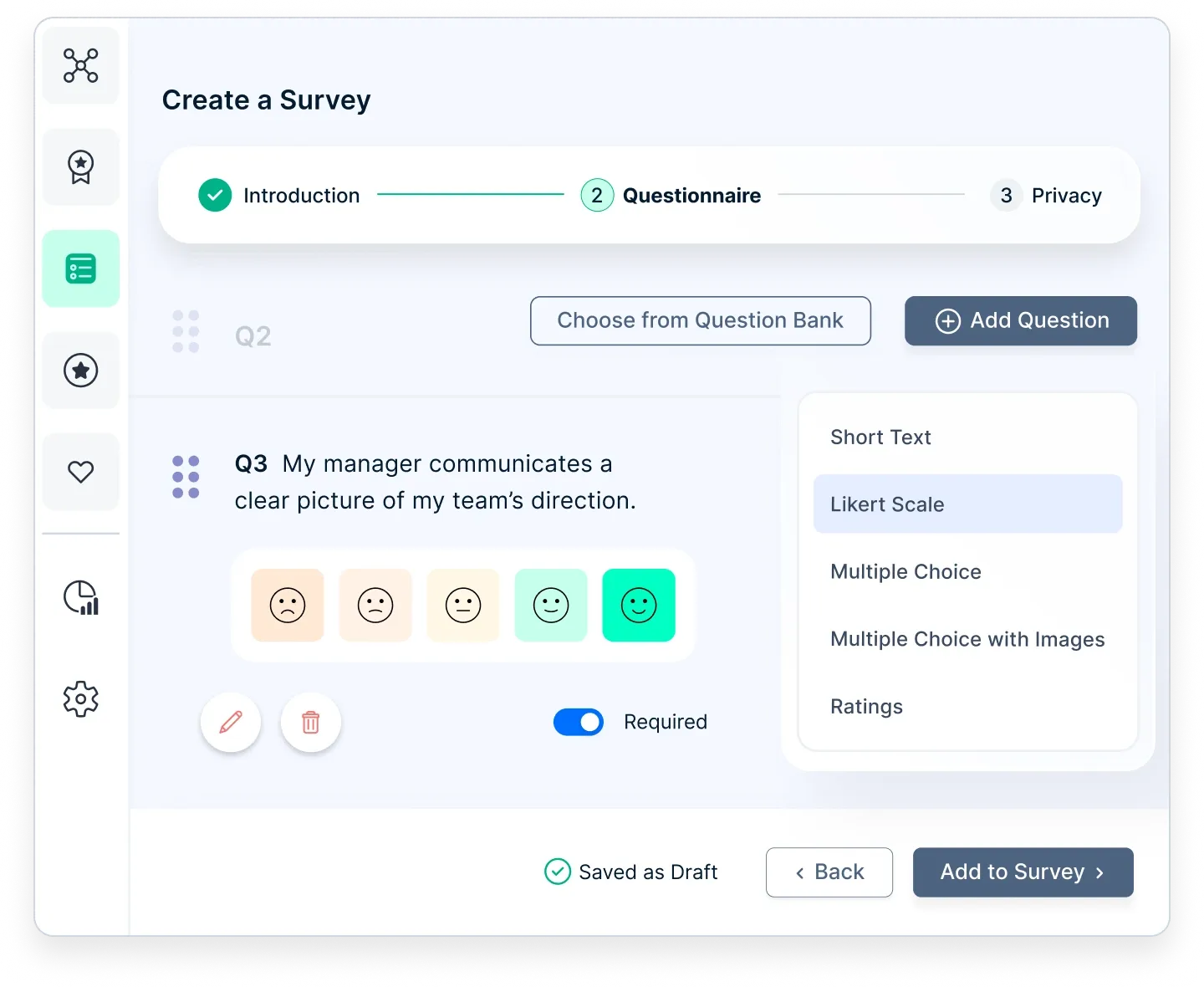
Convierta los comentarios de sus empleados en crecimiento laboral
Mida, analice y mejore el compromiso con las encuestas automatizadas de Empuls. Obtenga información clara para crear una plantilla más feliz y productiva.
Different types of employee surveys
Employee surveys are valuable tools for organizations to understand their workforce's perspectives and improve the overall work environment.
There are various types of surveys, each focusing on specific aspects of the employee experience. Here's a breakdown of three common types:
1. Encuestas sobre el compromiso de los empleados
Employee engagement refers to an employee's level of emotional commitment and connection to their work and organization. Engaged employees are highly motivated, productive, and loyal.
Several factors contribute to employee engagement, including:
- Meaningful work: Employees feel their work has a purpose and contributes to the organization's success.
- Oportunidades de crecimiento: Los empleados tienen acceso a programas de formación y desarrollo que les ayudan a avanzar en sus capacidades y carreras profesionales.
- Reconocimiento y recompensas: Los empleados se sienten apreciados por sus contribuciones y son recompensados por sus logros.
- Entorno laboral propicio: Los empleados se sienten valorados y respetados por sus compañeros y directivos, y disponen de los recursos que necesitan para tener éxito.
Employee engagement surveys are ideal for:
- Identificar a los empleados comprometidos y a los que no lo están: Los resultados de la encuesta pueden ayudarle a segmentar su plantilla en grupos comprometidos, no comprometidos y neutrales. Esto le permite centrar sus esfuerzos en volver a implicar a los empleados desmotivados y motivar aún más a los empleados ya comprometidos.
- Medir el progreso de las iniciativas de compromiso: La realización periódica de encuestas de compromiso le ayuda a realizar un seguimiento de sus progresos a lo largo del tiempo y a evaluar la eficacia de sus iniciativas de compromiso.
Sample questions for an employee survey that help you gauge their engagement:
- ¿Se siente valorado en el trabajo?
- ¿Con qué frecuencia reconoce su jefe sus esfuerzos?
- ¿Tiene acceso adecuado a herramientas de aprendizaje y desarrollo?
- ¿Cree que la dirección le proporciona suficiente
- autonomía para trabajar de forma independiente?
2. Encuestas sobre el pulso
Pulse surveys are short, frequent surveys designed to gather real-time feedback on specific topics.
Las encuestas por pulsos ofrecen varias ventajas:
- Puntualidad: Permiten recoger opiniones rápidamente y abordar los problemas antes de que se agraven.
- Información práctica: La naturaleza específica de las encuestas del pulso proporciona información específica que puede conducir a una acción inmediata.
- Mayor participación: Debido a su brevedad, las encuestas por pulsos suelen tener mayores índices de participación que las encuestas más largas.
Las encuestas por pulsos son ideales para:
- Evaluar la opinión de los empleados sobre iniciativas concretas: Tras el lanzamiento de un nuevo programa o política, una encuesta de opinión puede evaluar la reacción de los empleados e identificar áreas de mejora.
- Medir el compromiso de los empleados durante periodos de cambio: Durante fusiones, adquisiciones o reestructuraciones organizativas, las encuestas del pulso pueden ayudarle a conocer el sentimiento de los empleados y a abordar cualquier preocupación que surja.
Sample employee pulse survey questions include:
- En una escala del 1 al 5, ¿cuál es su grado de satisfacción con la reciente actividad de creación de equipos?
- ¿Cree que dispone de los recursos y el apoyo necesarios para pasar con éxito al nuevo flujo de trabajo?
- ¿Hasta qué punto confía en la dirección de la empresa tras los recientes cambios de liderazgo?
3. Encuestas de satisfacción de los empleados
Employee satisfaction refers to an employee's overall contentment with their job and workplace. Satisfied employees are more likely to be happy, productive, and have lower absenteeism rates.
Una baja satisfacción de los empleados puede disminuir su moral, reducir su motivación y aumentar la rotación. Entender con qué están satisfechos e insatisfechos los empleados permite a las organizaciones abordar las áreas problemáticas y mejorar la moral general.
Employee satisfaction surveys are ideal for:
- Measuring satisfaction with compensation and benefits: The survey can reveal employee sentiment regarding salary, benefits packages, and overall compensation competitiveness.
- Evaluar el equilibrio entre trabajo y vida privada: Recoger opiniones sobre la carga de trabajo, la flexibilidad y el equilibrio entre vida laboral y personal ayuda a identificar posibles áreas de mejora.
- Evaluar la cultura de la empresa: Los empleados pueden expresar sus opiniones sobre la cultura de la empresa, el estilo de liderazgo y los canales de comunicación.
Sample employee satisfaction survey questions:
- ¿Le gusta la cultura de la empresa?
- ¿Se siente unido a sus colegas?
- ¿Cree que somos una organización dinámica?
- ¿Se valora aquí su opinión?
- ¿Cuál es para usted la principal fuente de noticias sobre la empresa?
- ¿Cree que la dirección es transparente?
- ¿Es equitativa la distribución del trabajo en tu equipo?
4. Exit survey
Exit interviews are conducted with departing employees to understand their reasons for leaving and gather valuable feedback on their overall experience at the organization.
Las entrevistas de salida ofrecen información crucial que puede ayudar a las organizaciones a identificar áreas de mejora y abordar los problemas que podrían estar provocando la rotación de los empleados.
Realice entrevistas de salida con todos los empleados que se marchan, independientemente del motivo.
Sample questions (open-ended to encourage honest feedback):
- ¿Qué le impulsó a empezar a buscar otro trabajo?
- ¿Qué cambios en nuestra organización le atraerán de nuevo a esta empresa?
- ¿Se reconocieron aquí plenamente sus esfuerzos y contribuciones?
- ¿Qué cosas le gustan de esta organización?
- ¿En qué puede mejorar la organización?
5. Culture or diversity, equity & inclusion (DEI) survey
Estas encuestas evalúan las percepciones de los empleados sobre el entorno laboral, los valores y la inclusividad de su empresa. Ayudan a identificar las áreas en las que la cultura de su empresa puede reforzarse para fomentar el sentimiento de pertenencia de todos los empleados. Evalúa la cultura del lugar de trabajo de la organización y su compromiso con la diversidad, la equidad y la inclusión.
- Focus: Questions might address employee perceptions of respect, fairness, opportunities for advancement, and a sense of belonging for all employees.
- Benefits: Helps identify areas where the company culture can be strengthened to foster a more inclusive and positive work environment.
Sample culture or diversity, equity & inclusion (DEI) survey questions:
- Do you feel a sense of belonging within your team and organization?
- Do you believe your company provides equal opportunities for career advancement?
- Have you ever witnessed or experienced workplace discrimination?
- How confident are you that leadership prioritizes diversity and inclusion?
- Do you feel comfortable expressing your opinions without fear of bias?
Google collaborates with Performance Paradigm to redefine DEI with an innovative approach.
Google needs no introduction. The American multinational corporation and technology company, along with its parent company Alphabet, hordes around 182,500 full-time employees as of the end of 2023, making it very important for the organization to maintain diversity and cultural representation.
Google has made significant progress in increasing the representation of underrepresented groups in its workforce, particularly in leadership roles. The company has:
- Increased the number of Black, Latino, and Native American leaders by 30%, beating their goal by 3 years!
- Have more women than ever before in both technical and non-technical leadership roles, all around the world and in the USA.
- Hired more Black and Latino people than ever before, with Black employees making up 9.4% and Latino employees making up 9.0% of new hires in 2021.
Problem
Normally, many companies struggle to create diversity and inclusion (DEI) programs that work. Even when they try, the programs may not be effective.
With the company so vast and inclusive, how does Google maintain diversity, equity, and inclusion? It was a challenging task for Google, but achievable.
So, they partnered with Performance Paradigm, a company that consults businesses on DEI issues. Together, Google and Performance Paradigm created programs to help Google leaders and staff become more engaged in DEI.
The programs are designed to change the way people think about race, gender, and unconscious bias.
Solution
Just implementing a DEI program may not be effective. “For so long, we looked up at largely white men and asked them how the organization is doing on diversity, equity, and inclusion,” Michael Munoz, who leads diversity, equity, and inclusion within Marketing at Google, tells We First.
“We need to look at the Black, Latinx, Asian, indigenous populations and ask, ‘How are we doing at building a culture where you feel empowered and a strong sense of psychological safety?’”
- So, as a solution, they launched a program called Digital Human. The program concentrates on four key behaviors, including 'Show up', 'Be present', 'Creative visibility', and 'Proximate.' It includes workshops, exercises, and videos.
One activity that set the program apart from the rest was ‘2, 24, 25.’ The program allowed the managers to pick two people on their team, one that they knew fairly well and one that they barely knew.
Within 24 hours, schedule a 25-minute meeting with them and talk about them. The program lasts for 12 weeks.
The purpose was to increase the sense of belongingness. “We still used art and all the experiential things to deliver it, but we wouldn't let them fast forward. We wouldn't let them binge, they had to stop and do the work,” Butler claimed.
- Another program that they launched was called Examined Human. This program uses art and music to help people connect and learn about different cultures. These programs are designed to help Google create a more inclusive workplace where everyone feels like they belong.
- Implemented R.I.C.H dialogue to create community. “R.I.C.H. is an acronym for race, identity, culture, and heritage,” says Butler.
‘It's a type of communication tool that accelerates relationship management by exploring all the different points of view around race, identity, culture, and heritage.”
Impact
The DEI training at Google allowed the organization to see exceptional results.
- The DEI program dealt with the discomfort and allowed the marginalized, underrepresented people to feel included, and heard. Include a sense of belongingness.
- Facilitate communication and community building. Have a long-lasting impact.
6. Training surveys
Training surveys assess the effectiveness of training programs and employee learning experiences.
Las encuestas de formación proporcionan información valiosa sobre si los programas de formación cumplen sus objetivos y dotan a los empleados de los conocimientos y habilidades que necesitan para tener éxito.
Las encuestas de formación son ideales para:
- Medir los resultados del aprendizaje: Evaluar si los programas de formación están ayudando a los empleados a adquirir los conocimientos y habilidades deseados.
- Gauging participant satisfaction: Assess employee satisfaction with the training program's content, delivery method, and overall effectiveness.
- Identificar áreas de mejora: Recoger opiniones sobre cómo perfeccionar y mejorar los futuros programas de formación.
Sample employee training survey questions:
- ¿El contenido de la formación respondió a sus expectativas?
- ¿El formador fue capaz de responder eficazmente a su pregunta?
- ¿Cómo valora el contenido y la pertinencia de la formación?
- ¿Cómo califica al instructor?
- ¿Con qué frecuencia debemos realizar estas sesiones de formación?
7. 360-degree survey
360-degree feedback surveys provide a comprehensive evaluation of an employee's performance by gathering feedback from multiple sources, including peers, managers, subordinates, and sometimes even clients or customers.
El feedback de 360 grados ofrece una perspectiva completa de los puntos fuertes y débiles de un empleado, proporcionando información valiosa para su desarrollo.
Las encuestas de feedback de 360 grados son ideales para:
- Evaluación del rendimiento: Cuando se combinan con la autoevaluación y los comentarios de los jefes, las encuestas de 360 grados proporcionan una visión holística del rendimiento de los empleados.
- Identificar áreas de desarrollo: El feedback puede poner de relieve áreas específicas en las que un empleado puede seguir desarrollando sus habilidades y conocimientos.
Sample 360-degree survey questions:
- How effectively does this employee communicate with team members and other departments?
- How well does this employee handle constructive feedback and use it for improvement?
- How would you rate this employee’s leadership or teamwork skills?
- How effectively does this employee contribute to team goals and company objectives?
- What is one strength and one area for improvement for this employee?

Download Free Employee Survey Templates for Instant Feedback
Get access to ready-to-use survey templates designed to capture valuable employee feedback. Whether you need engagement, DEI, or pulse surveys, find the right template to enhance your workplace experience.
The Do's and Don'ts of employee surveys
A continuación se indica lo que debe hacer y lo que debe evitar al realizar una encuesta a los empleados:
Lo que hay que hacer:
Siga estos consejos para que sus encuestas tengan éxito:
- Explica claramente por qué pides opiniones (comunica el propósito).
- Garantizar el anonimato para obtener respuestas sinceras (mantener el anonimato de las respuestas).
- Destaque lo que va bien para levantar la moral (celebre los éxitos de la empresa).
- Comparta los resultados para que los empleados vean que su voz importa (comunique los resultados de la encuesta).
- Utilice preguntas fáciles de entender que eviten los prejuicios (utilice preguntas claras e imparciales).
- Sé conciso para evitar que te lleve demasiado tiempo (haz encuestas breves y centradas).
- Utilice un lenguaje que los empleados entiendan (hable el idioma del empleado).
- Piense en las encuestas como interacciones con su marca (trate las encuestas como interacciones con la marca).
- Permita respuestas detalladas más allá de las respuestas sí/no (formule preguntas abiertas).
- Tome medidas en función de la información que reciba (utilice los resultados de las encuestas).
Lo que no se debe hacer:
Avoid these mistakes that can make your employee surveys ineffective:
- Abrumar a los empleados con demasiadas preguntas (hacer demasiadas preguntas).
- Encuestar con demasiada frecuencia puede resultar molesto (desplegar encuestas con demasiada frecuencia).
- Pedir opiniones sin llevarlas a la práctica (encuestar sin actuar).
- Frases que incitan a responder (preguntas capciosas).
- Underestimating how long it takes to complete the study (understate survey length).
- Desalentar la participación debido a demasiadas encuestas (crear fatiga de encuesta).
Sin embargo, no basta con poner en práctica lo que hay que hacer y lo que no hay que hacer. Hay que conocer las mejores prácticas a realizar durante todo el tiempo que dure la encuesta a los empleados.
Employee survey best practices
Las encuestas de empleados eficaces pueden proporcionar información valiosa sobre la cultura de la empresa, la satisfacción de los empleados y las áreas de mejora. He aquí un desglose de las mejores prácticas para cada etapa del proceso de encuesta:
1. Antes de la encuesta
La ideación de la encuesta es tan importante como su realización. Así que ten en cuenta los siguientes detalles:
- Define your goals: Identify what you want to learn from the survey. Are you interested in employee engagement, work-life balance, or specific department processes? Focused goals will guide your question development.
- Genere confianza y anonimato: Los empleados deben sentirse cómodos a la hora de dar su opinión. Haga hincapié en el anonimato y la confidencialidad durante todo el proceso de la encuesta.
- Craft clear questions: Use clear, concise, and unbiased language. Avoid jargon or leading questions that influence responses.
- Communicate effectively: Inform employees about the survey purpose, timeline, and how their feedback will be used. Encourage participation and address any concerns.
2. Durante la encuesta
Durante la encuesta, aplique los siguientes factores:
- Choose the right platform: Select a user-friendly platform that is accessible on various devices. Consider mobile-friendliness and ease of navigation.
- Keep it short: A concise survey with a reasonable completion time will improve participation rates. Prioritize the most important questions.
- Promote participation: Generate interest through internal communication channels. Use email reminders and highlight the importance of employee feedback.
3. Después de la encuesta
Tras la encuesta, plantéate hacer lo siguiente:
- Analyze the data: Carefully analyze the results, identifying trends and areas requiring further investigation.
- Share the findings: Employees value transparency. Share key findings and explain how the feedback will be used to improve the workplace.
- Take action: Develop concrete action plans based on the survey results. Communicate these plans and demonstrate a commitment to addressing employee concerns.
Employee survey questions about management
He aquí 30 preguntas esenciales de la encuesta de empleados sobre gestión, que pueden ayudar a las organizaciones a comprender los puntos fuertes y débiles de sus prácticas de gestión y a tomar medidas para mejorar la satisfacción y el compromiso de los empleados.
Preguntas de la encuesta a los empleados sobre la gestión (comunicación)
A good supervisor-employee connection is built on clear and consistent communication. Frustration, uncertainty, and demotivation can result from poor dialogue at the top. Of course, identifying where dialogue may fail is not always straightforward.
Estas preguntas le ayudarán a identificar las áreas en las que la comunicación puede ser deficiente o insuficiente.
1. Has management communicated performance expectations?
2. ¿Comunica eficazmente su jefe la información que usted necesita comprender?
3. ¿Explica la dirección las razones de las decisiones tomadas?
4. ¿Resuelven los directivos las diferencias con profesionalidad?
5. Does your supervisor explain how the organization's plans affect you?
6. Does your boss communicate changes to company practices or benefits?
7. ¿Con qué frecuencia recibe reconocimiento de su supervisor?
8. Were you recognized the last time you finished a project?
Pregunta de la encuesta a los empleados sobre la gestión (confianza y respeto)
Trust is the foundation of all good relationships between employees and their superiors. Employees who don't feel safe and valued at work are less likely to ask questions, bring problems to management's attention, and feel motivated or empowered to do their best.
Por eso es tan importante que los líderes generen confianza y respeto mutuo en sus equipos. Aquí tienes algunas preguntas que puedes utilizar para medir lo cómodos que se sienten tus empleados con su jefe:
9. ¿Su jefe crea un entorno abierto y de confianza?
10. ¿Trata su supervisor con equidad a todos los miembros del equipo?
11. ¿Es receptivo su jefe a ideas, peticiones y sugerencias?
12. Cuando planteas un problema a tu superior, ¿confías en que te escuche?
13. 13. ¿Te hace sentir tu jefe una parte valiosa del equipo?
Pregunta de la encuesta a los empleados sobre la gestión (eficacia)
14. ¿En qué medida son eficaces sus líderes a la hora de dirigir la organización?
15. Do they have the skills, training, and resources to succeed?
16. ¿Confía en la actuación de su jefe inmediato?
17. ¿Tiene su jefe los conocimientos y la capacidad necesarios para ayudarle a usted y a su equipo a tener éxito?
18. ¿Mantiene su jefe altos niveles de conducta?
19. ¿Ha intentado su jefe mejorar las cosas en el último año?
20. ¿Su jefe toma decisiones eficaces de forma sistemática?
These are excellent questions to ask when the boss is doing everything right on paper, but the team is still sloppy. The responses can help spot possible gaps in a manager's skills or tools or resources that they may require to be successful.
Pregunta de la encuesta a los empleados sobre la gestión (desarrollo profesional)
Career development is a key factor in employee engagement. Employees who see a future and growth path in their company will likely be engaged and motivated to
succeed. Managers play a key role in developing employees and providing growth opportunities.
These questions will help you see how well your managers train and develop their teams and identify opportunities to address communication or training gaps.
21. ¿Hablan usted y su supervisor sobre su carrera en esta organización? 22. ¿Se encuentra
¿crecer y desarrollar su carrera en esta empresa?
23. ¿Sabes qué pasos tienes que dar para ascender en la organización el año que viene?
24. ¿Cree que aquí puede desarrollar todo su potencial?
25. ¿Tienes suficientes oportunidades de aprendizaje en el trabajo?
Employee survey question about management (work-life balance)
Work-life balance isn't just a nice thing to do; it's important to the well-being of your employees and, therefore, your bottom line. A poor balance between work and family life increases stress, employee burnout, and isolation. These questions will help you identify how well you manage work-life balance in your teams.
26. ¿Comprende su supervisor la importancia de su vida personal y familiar?
27. ¿Su jefe se preocupa por su bienestar?
28. Is your workload generally reasonable for your role?
29. ¿Su supervisor fija plazos justos?
30. ¿Se siente apoyado por su jefe?
Leverage Empuls employee survey tool: Unlock actionable insights to boost engagement
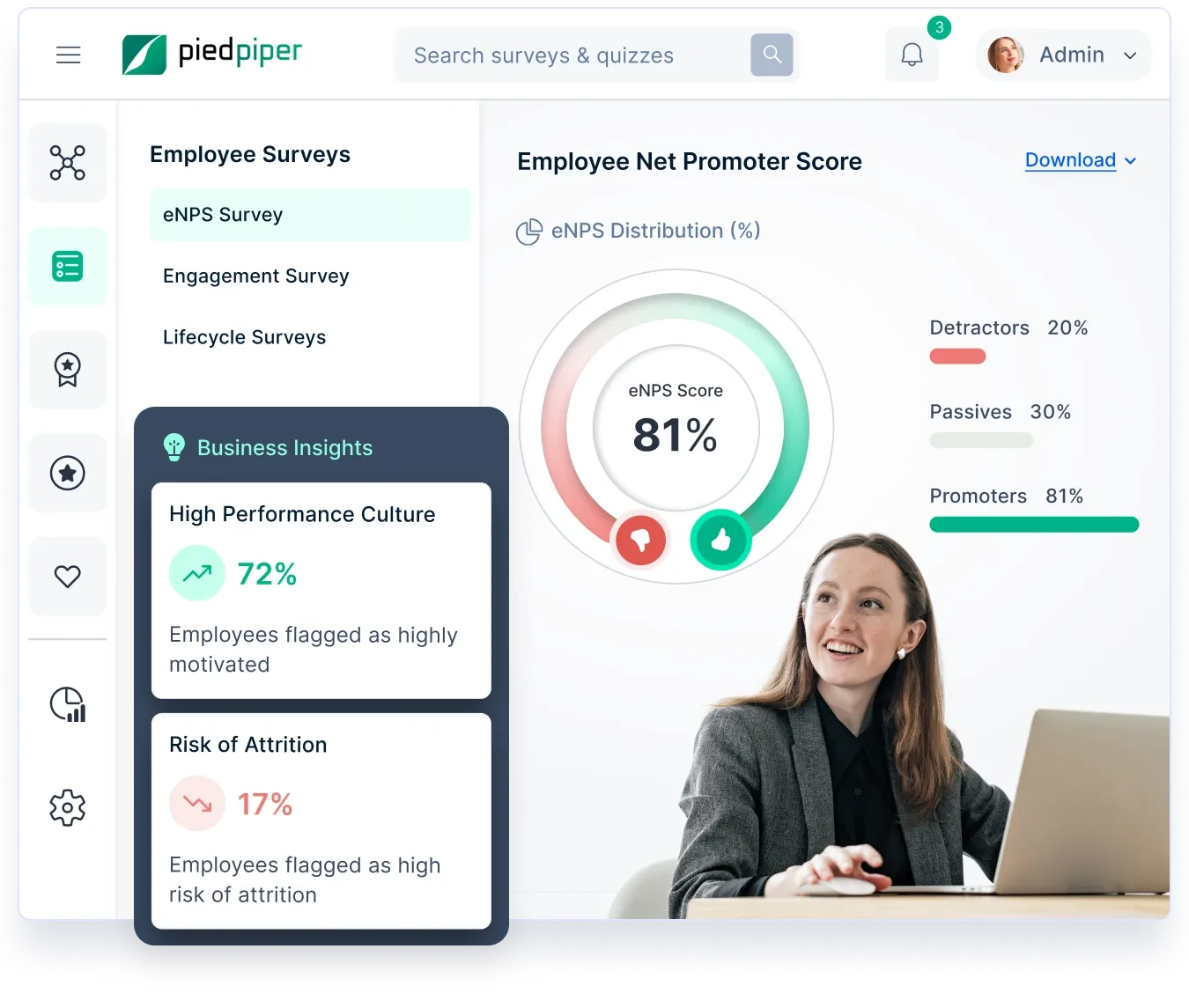
Understanding what drives employee satisfaction and productivity is the key to building a thriving workplace. Empuls’ employee survey tool helps organizations tap into employee sentiment, uncover real concerns, and take meaningful actions that drive engagement and retention. With a data-driven approach, Empuls makes feedback more than just a checkbox—it turns it into a strategic advantage.
1. Deep employee insights through engagement & pulse surveys
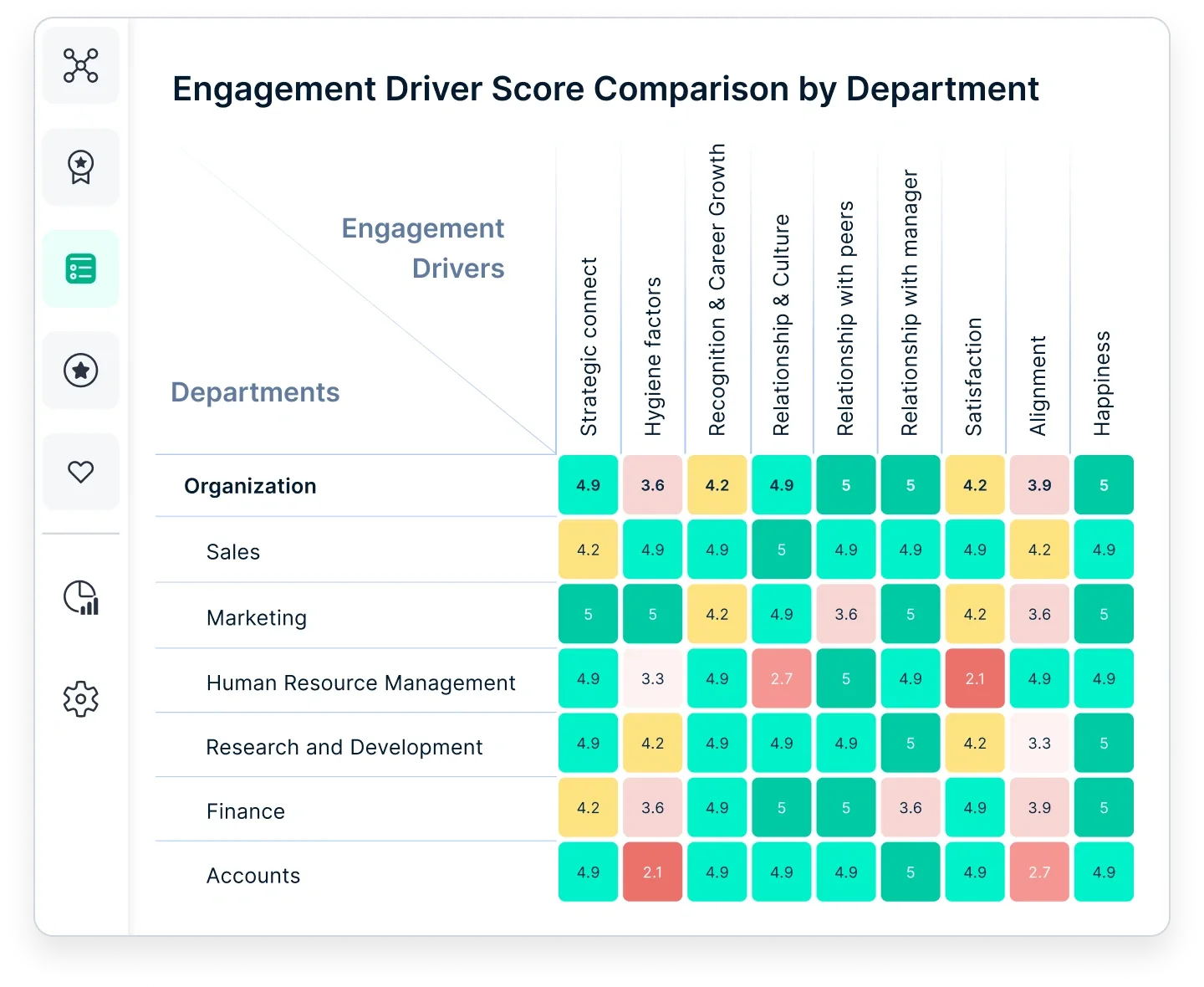
Traditional surveys often fail to capture the real pulse of an organization. Empuls changes this by offering real-time pulse surveys that go beyond surface-level questions.
With AI-powered sentiment analysis and trend tracking, leaders can detect signs of disengagement and address issues before they escalate. These insights help organizations create a continuously evolving workplace to meet employee needs.
2. Lifecycle surveys for every employee touchpoint
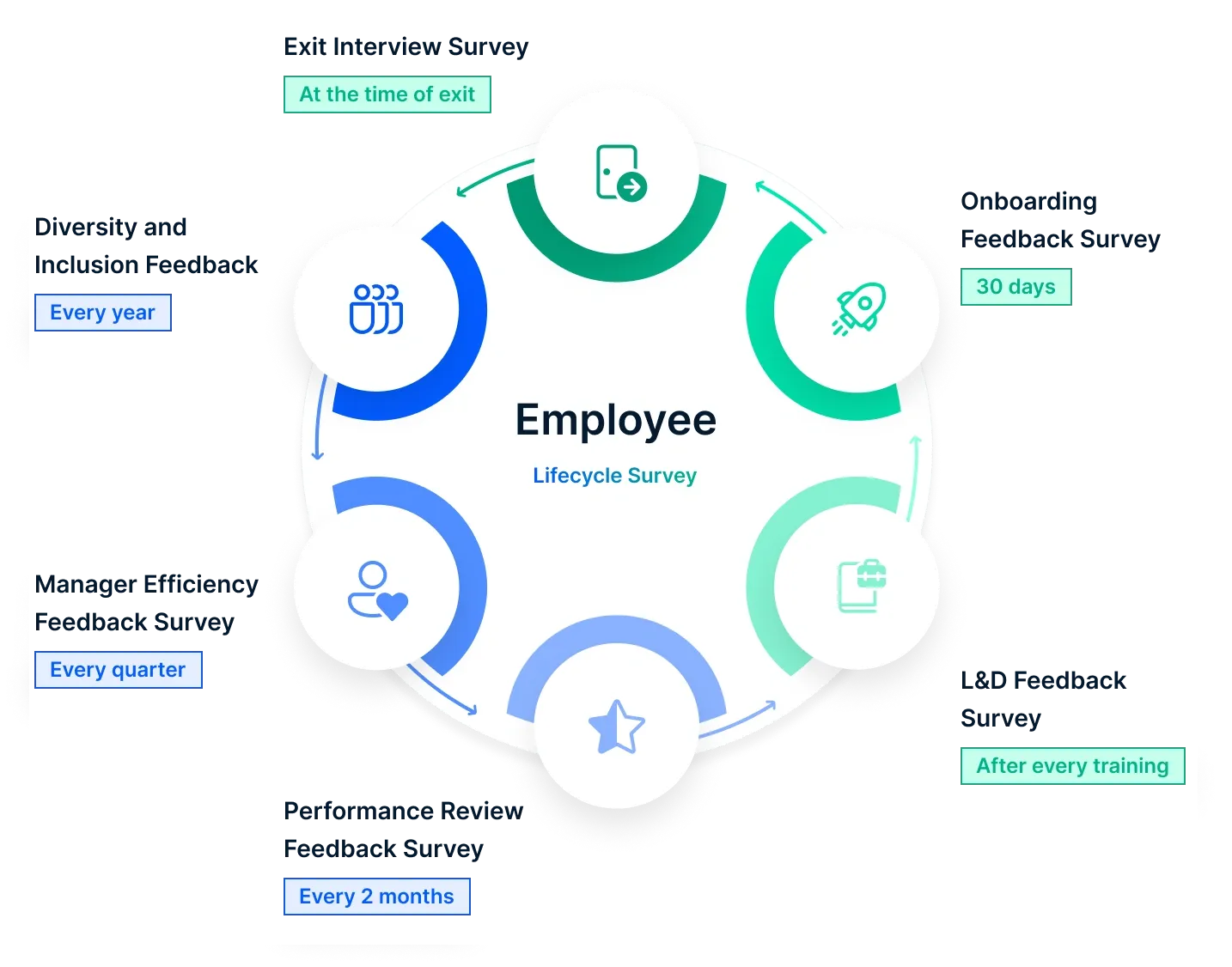
Employee experiences change over time, and a one-time survey is never enough. Empuls provides lifecycle surveys that track employee sentiment from onboarding to exit.
Organizations can use structured feedback loops to understand what’s working and what needs improvement at different stages of employment. Companies gain a well-rounded view of their workforce with specialized surveys covering DEIB, leadership effectiveness, and workplace culture.
3. Custom surveys for targeted feedback
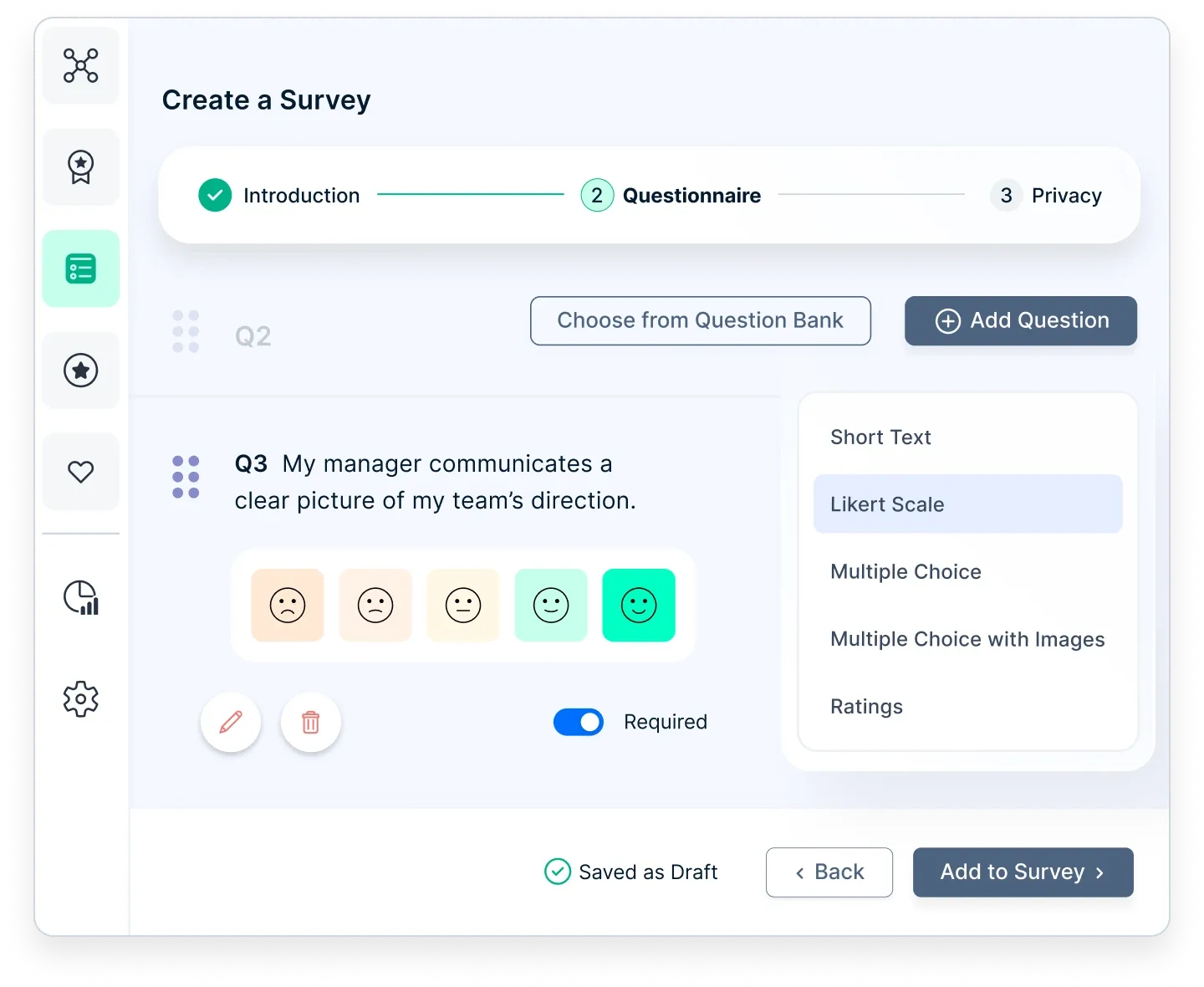
Every organization has unique challenges, and standard surveys don’t always fit the bill. Empuls enables companies to create fully customizable surveys focusing on their needs. With a rich question bank and the ability to design quizzes, businesses can capture precise insights that fuel better decision-making.
Whether measuring a new policy’s impact or understanding employee expectations, custom surveys make data collection more relevant and effective.
4. AI-driven conversations for honest feedback
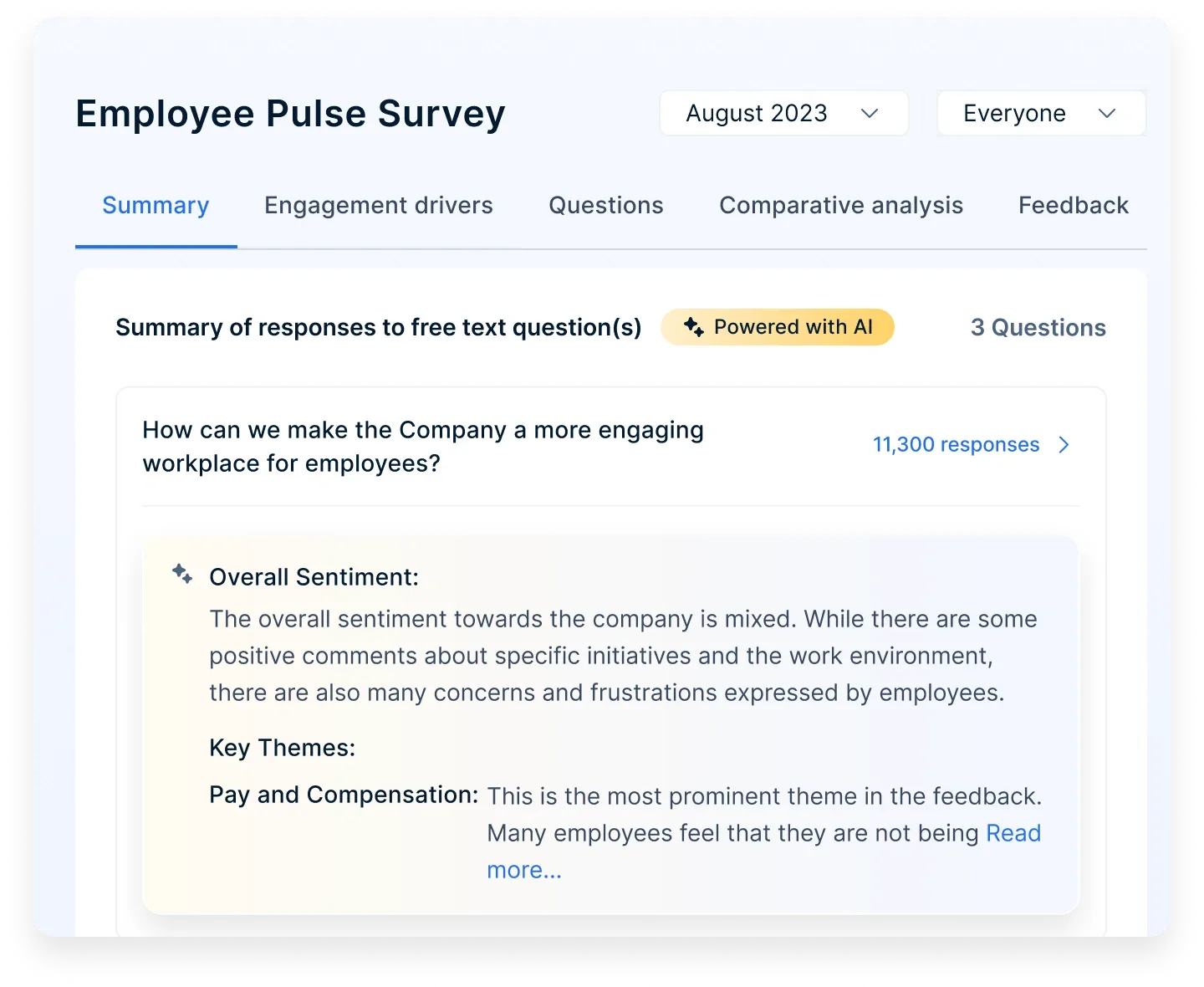
Employees often hesitate to provide candid feedback in traditional survey formats. Empuls overcomes this challenge with AI-driven conversations that feel natural and engaging.
By adapting questions in real-time based on responses, this tool encourages employees to share their true opinions. These personalized interactions make feedback more meaningful, helping organizations uncover issues that might go unnoticed.
5. Data-backed decisions with actionable reports
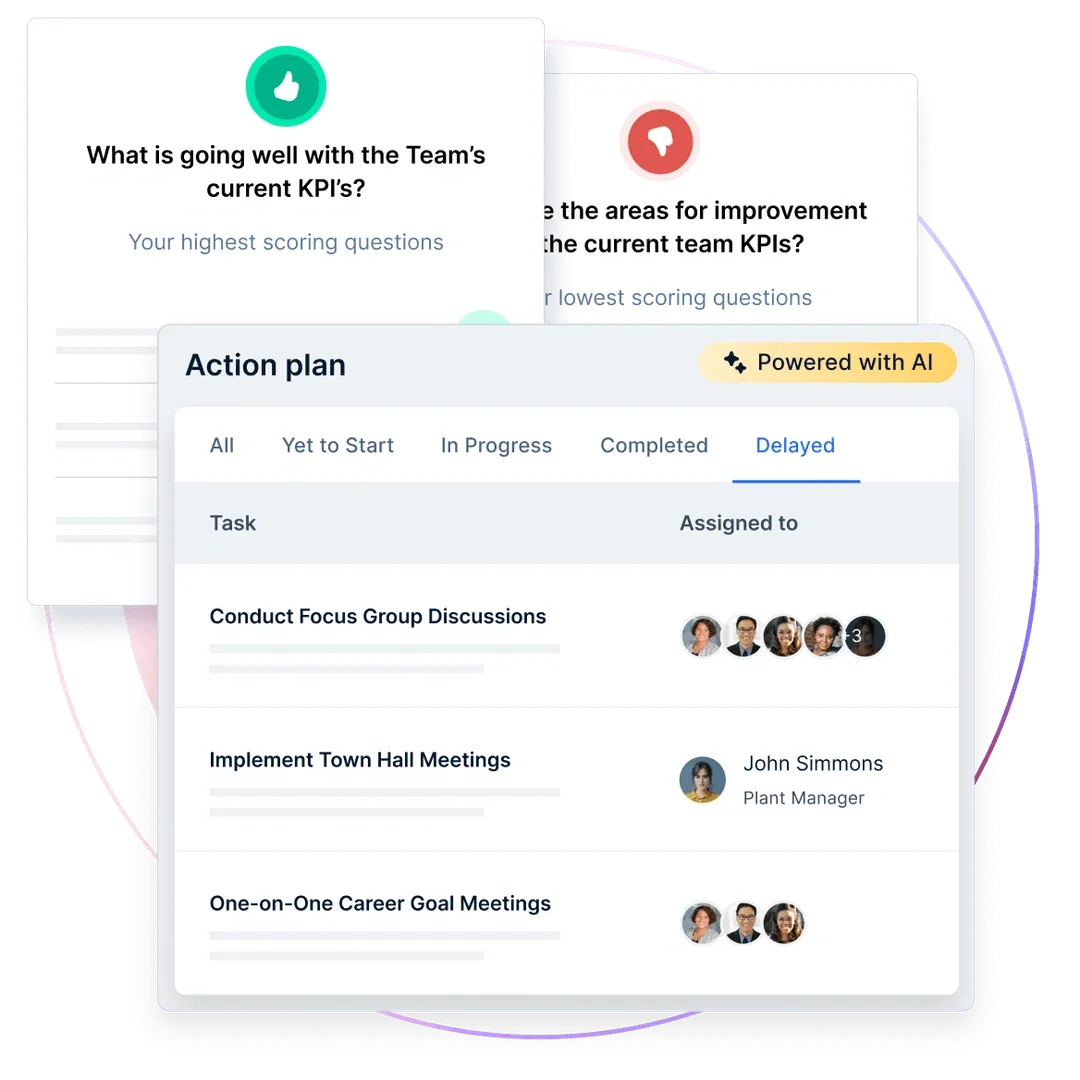
Gathering feedback is just the first step; acting on it makes a difference. Empuls turns survey results into detailed, visually rich reports highlighting key trends and pain points. Organizations can compare their performance against industry standards with AI-powered analytics and benchmarking tools.
Automated recommendations provide clear next steps, ensuring that survey insights lead to real improvements in employee engagement.
Turn feedback into meaningful change with Empuls
Empuls empowers HR leaders and managers to listen, act, and create a workplace where employees feel valued. Move beyond surveys—transform employee insights into measurable improvements that enhance culture and performance.
Ready to build an engaged workforce? Explore Empuls Employee Surveys Today
Conclusión
A well-structured employee survey lies in its ability to provide valuable insights into the health and well-being of your organization. Moreover, they are a confidential communication channel for employees to share their honest opinions and experiences. So, you can use employee surveys to turn the tide against employee disengagement and dissatisfaction among employees.
However, to align them with shared organizational values, motivate the employees, and reinforce positive behaviors to create a truly engaged work environment, you need a platform that goes beyond conducting just surveys.This is where Empuls can help. Empuls is an employee engagement platform that enables organizations to connect with employees. This holistic solution:
- Facilitar la retroalimentación y la mejora continuas durante el ciclo de vida del empleado mediante encuestas en tiempo real.
- Ayuda a planificar actividades de compromiso de los empleados basadas en datos
- Puesta a punto de los planes de acción para mejorar el eNPS
Por lo tanto, recopile comentarios significativos, identifique los impulsores del compromiso y tome medidas basadas en datos para mejorar la experiencia y la cultura de los empleados con Empuls.
Preguntas frecuentes
1. ¿Cuáles son las buenas preguntas de encuesta para los empleados?
Good survey questions focus on engagement, job satisfaction, leadership, and workplace culture. Examples include: “Do you feel valued at work?”, “How likely are you to recommend this company as a great place to work?”, and “What improvements would enhance your experience?”
2. Are employee surveys a good idea?
Yes, employee surveys provide valuable insights into workplace sentiment, help identify issues and improve engagement. When conducted effectively, they can enhance employee satisfaction and contribute to better retention and performance.
3. Are employee surveys really anonymous?
Most employee surveys are anonymous, but it depends on how they are conducted. Organizations should clearly communicate anonymity policies to ensure employees feel safe providing honest feedback.
4. How often should companies conduct employee surveys?
The frequency of surveys depends on the organization’s goals. Annual surveys provide a broad overview, while quarterly or pulse surveys help track ongoing engagement and identify issues in real-time.
5. What are the different types of employee surveys?
Common types include engagement surveys, pulse surveys, exit surveys, onboarding surveys, and 360-degree feedback surveys. Each serves a different purpose, from measuring satisfaction to improving leadership effectiveness.
6. How can companies encourage honest employee feedback?
To get candid responses, companies should ensure surveys are anonymous, communicate how feedback will be used, and follow up with visible actions based on survey results. Creating a culture of trust makes employees more willing to share their thoughts.









